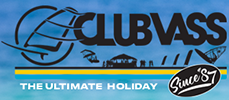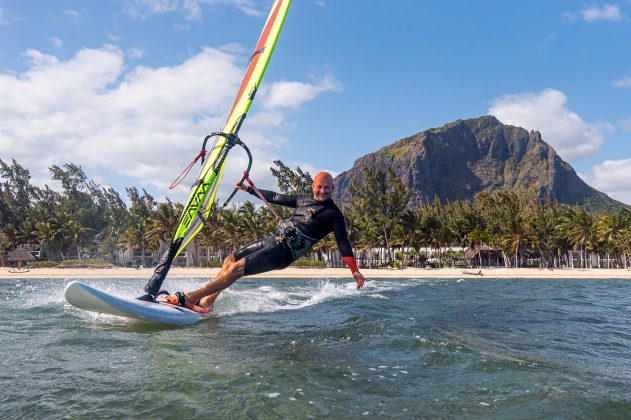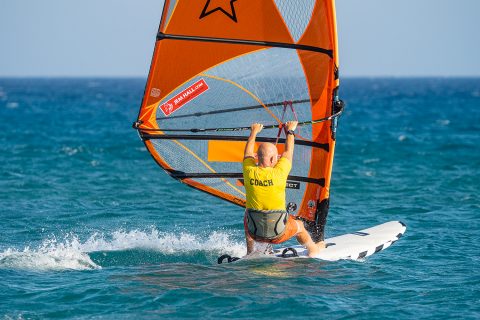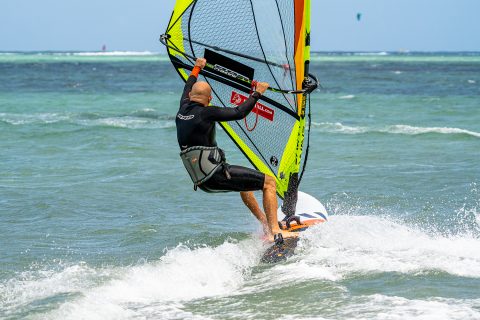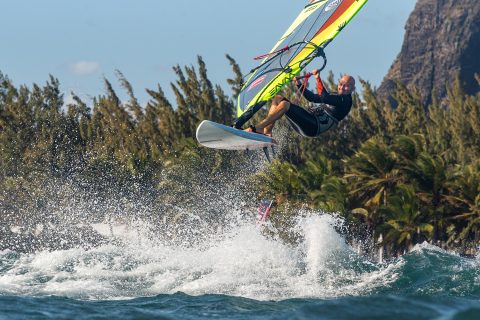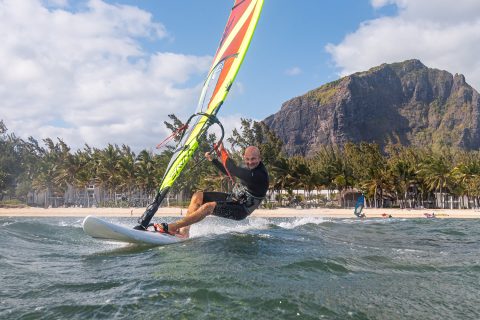JEM HALL
MOVE ON UP – WINDSURFING TECHNIQUE
Small changes = big gains
This month I look at how making a few subtle and precise changes to your technique can yield some massive benefits. The added bonus is that not only will these small changes assist your progression in the key fundamentals, but also that, once locked in, they ensure you advance in the more difficult, or complex manoeuvres. I will provide seven super actions to work on and provide the tips, and / or benefits, where relevant.
WORDS – Jem Hall // PHOTOS – Eye Sea You Photo.
SUPER SEVEN
All these moves flow to each other and I have presented them in somewhat of an order of progression. So as you embrace these small changes, it is easier to progress into the latter actions I propose.
Front foot facing forward This should already be taking place, and pointed out by an instructor during your first windsurfing sessions. Getting this in place early in your journey will hugely boost your early planing, transition exits and give you a great non-planing stance. It should also be in evidence in gybe exits, pre-planing stance and when sailing upwind non-planing (chugging).
Key benefit: It allows the hips to open, and this in turn means you will not oversheet the sail so much and thereby lose speed, and balance.
Front hand back (FHB) This was covered extensively in my recent ‘Handy Hints’ piece in June 2022, so please refresh yourselves there. All of these ‘changes’ are game changers, yet this has to be one of the biggest. It is also the one that you will see so many people not actually doing! It is key for carve gybe preparation and early planing. It gets the rig upright for planing and for gybing / riding, as it assists in driving the rig forward.
Key tip: this is hard to achieve without long enough harness lines, and the reason why many people have their front hand forward is either due to them using short lines, or a hangover thereof from previous long term use of short lines, so ensure your harness lines are long enough. Edge your hand back nearer and nearer to the front line and ensure you have your hips lower then you are used to, so you are better placed to react to changes in power.
- CAPTION: Fire out of your gybes with your front hand back to get more power, and your front foot forward to open your hips.
Bent Back Leg (BBL) to 90° Many key moves are so much easier to achieve once this action is made, like beach and waterstarts, early planing, and other areas like jumping with more control. Bending your back leg will raise the tail and not sink it (push it down). Many losses of control can be traced back to extending your back leg. A great way to help achieve a BBL is to extend your front arm more in many situations, as then we can ‘extend and bend’. This action powers up the rig and means we have to get lower, through a BBL, in order to match this.
Key benefit: having a BBL allows you to move outboards and from this position you can then straighten your front leg and be in a better position to not sink the tail. This action not only gives you leverage over the board, but it also helps you steer it downwind. One mantra you might use to get you in the mood is “Get down, James Brown” and you can also try dropping either hand, whilst blasting or jumping, to further embrace your love for a BBL.
Letting go If you are already well acquainted with my articles then you will know my penchant for one-handed moves! Taking a hand off, in light winds, can be great for understanding where to position your hands and how to control power. Dropping your front hand when hooked in just lets you feel so much more from the rig and will force you to use your hips more, steer with your legs and read the water and wind better. Taking it a stage further, one-handed carving 360s help you understand where the rig needs to be and then dropping a hand in a top turn, when wave riding, will get you positioning the rig better, and also stop you oversheeting the sail.
Key tip: if we look at dropping your hand when hooked in, then begin by first releasing your front hand grip, then take it off the boom for a second, and then move onto more time with the hand hanging down near the water. You can start in lighter winds and then move towards conquering it when more powered up.
- Extending your front arm into the carve gybe will often see a bent back leg following and both will smooth your turns.
Precise Preparation When coaching, people are often telling me they have problems in the middle or end of a transition and time and again I often identify that the area to work on is the beginning, or preparation phase, and I hit them with this – ‘by failing to prepare (precisely), we are preparing to fail’.
Key tip: aim to understand the exact actions that should be taken when setting up for a move and in what order. In the tack and gybe, I use the H.U.F. principle and this is Hand (movement), Unhook, and then Feet out of the footstraps.
Key benefit: without doubt the main benefit of precise preparation is that it gets your hips in a better position to move earlier, and with more fluidity, and this will help hugely in the challenging transition (footwork) part of a tack, or a gybe.
- Back hand back, then unhook and then get the back foot out of the footstrap in order to put more precision into your gybe preparation.
Sheet out This is the action of letting the sail out, often through pushing out on the back hand with a twist of the shoulders. I call this ‘changing your recovery plan’. When a lot of windsurfers are under pressure, or out of position, they often go to the ‘default recovery plan’ of sheeting in, and standing up thereby follows, and with a certain sense of bemusement, the final straw is looking at the sail for some sort of feedback, believe me none will come! So if we sheet out to recover, we give the rig a chance to breathe. Situations where this is paramount are after a beach/water start, starting to get planing, exiting a gybe clew first, and your in-flight control in a jump.
Key benefit: if we sheet out we will, more than likely, drop down lower and pull down on the boom, which is a much more effective ‘recovery plan’. Another action that then might follow is looking upwind to assess the wind as we have bought some time to do this by allowing the sail to breathe and thereby you, and it, can reset.
- Keep that mast arm out to sheet out when exiting your gybes clew first, so that the sail has time to breathe and this will give you more balance.
Jump across the wind If you take this line then you are in a better position to pop the board off your toes which will then bring the rail up so the wind goes under the board, lifting, guiding and propelling it. It will also give you more speed through the air so you have time to fly and steer. It might be said, where you take off is where you land, so if you take off into the wind you will land into the wind, and henceforth have less speed and power for a clean getaway.
Key tip: focus on the action of popping, the timing of the pushing down on the back leg and the pulling up on the front arm and leg. Do this as opposed to looking for the steeper chop / wave upwind. So you must, in effect, jump the bump rather then letting the ramp throw you up. Be a pilot not a passenger. The best way to boost your popping, and across wind jumping, is to do tail grab jumps.
- Take off across the wind to pop off your toes and give you more speed and time through the air.
TAKE TIME TO TUNE
It is not only in our actions that we can yield some fantastic results from some small changes, it is also very much in our tuning. First up you have got to ‘make the change’ and be ready to embrace the experiment of tuning. Here are some easy actions you can consider:
- Change your outhaul by a cm, either increasing it for more control, or decreasing it for more power. Be willing to do this in the water, in the shallows, or on the beach.
- Move the mastfoot back or forward a cm. Back can give you more speed, or pop. Forward can give you more control.
- Change your fin size up to get more lift, or down to get more control.
I have written a plethora of tuning articles so you can get more information either in back issues, or online at windsurf.co.uk. Knowledge is power people!
- Bending your back leg to 90 degrees will get you out and down, with more speed and control then following.
Ezzy sails, RRD (boards, wetsuits & softwear), Chinook & Black Project fins sponsor Jem Hall. Get him live and direct on one of his highly acclaimed coaching holidays – check out his website www.jemhall.com for details. You can also follow him on twitter / Facebook / Instagram.

